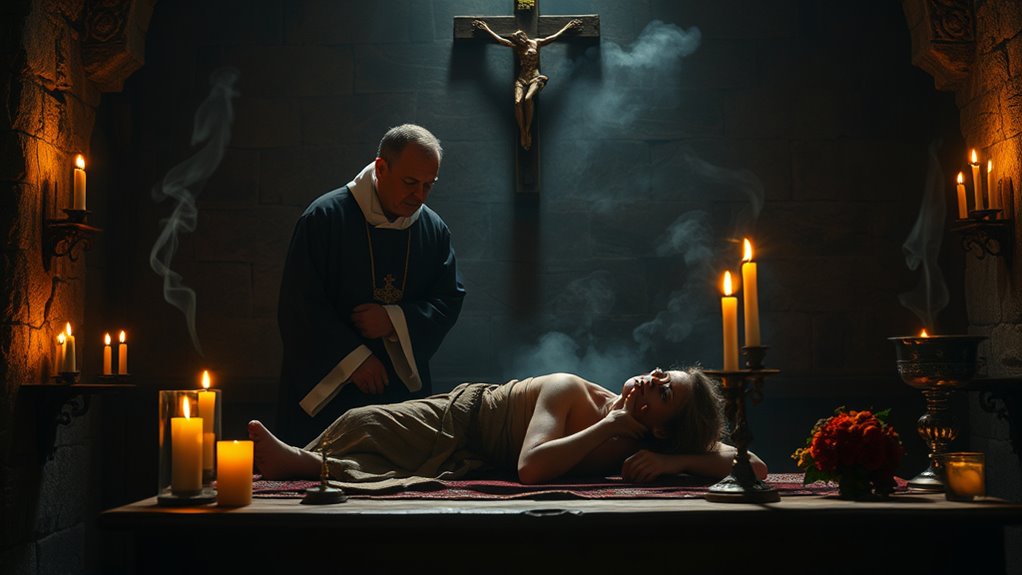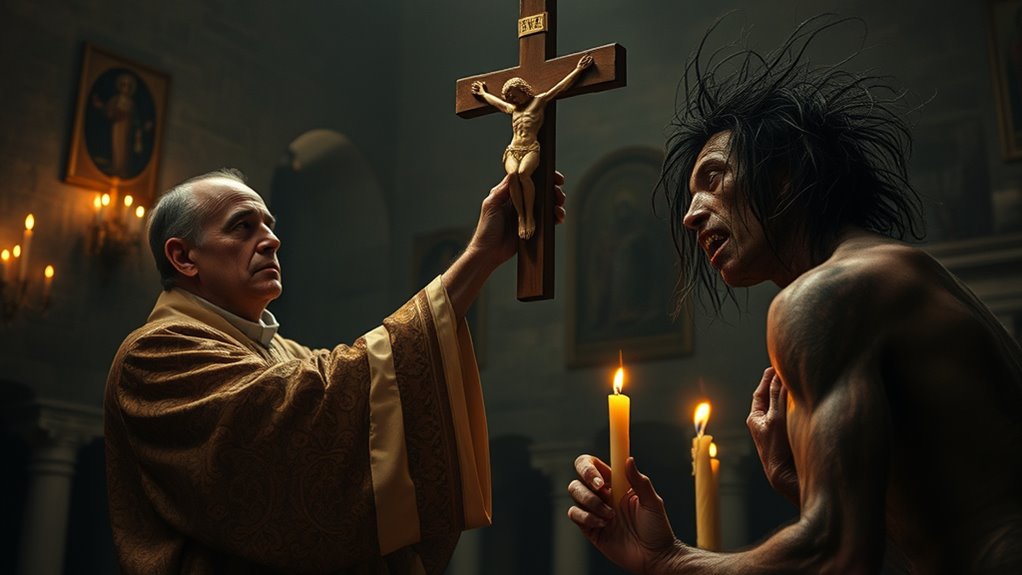The Exorcist’s Rite involves confronting a demon through prayer, scripture, and invoking divine authority, primarily in the name of Jesus Christ. You begin by evaluating signs of possession and then perform rituals that include powerful prayers and biblical readings to weaken the demon’s hold. During the process, resistance like thrashing or screaming may occur, indicating the demon’s struggle. To discover more about how these spiritual battles unfold and succeed, keep exploring what makes exorcisms effective.
Key Takeaways
- Exorcisms invoke divine authority through prayers, scripture, and the name of Jesus Christ to confront and expel demonic entities.
- The ritual involves spiritual discernment to identify signs of possession and resistance during the exorcism process.
- Core components include scripture readings, faith-based prayers, and visualization of divine presence to strengthen spiritual authority.
- Signs of demonic resistance, such as screaming and physical agitation, indicate the demon’s struggle to maintain control.
- The primary goal is complete expulsion of the demon, restoring peace and spiritual harmony to the possessed individual.

Have you ever wondered what an exorcism entails? It’s more than just a ritual; it’s a profound act rooted in faith based healing and spiritual warfare. When someone faces what they believe to be demonic possession, it’s not only about removing an uninvited spirit but also about restoring spiritual balance and healing the afflicted’s soul. During an exorcism, the priest or spiritual leader acts as a conduit for divine power, confronting the dark forces that have taken hold. This confrontation isn’t accidental—it’s a deliberate engagement in spiritual warfare, where faith serves as the weapon against malevolent entities.
Exorcism: a spiritual battle of faith, healing, and divine authority against dark forces.
The rite begins with a thorough assessment, often involving prayers, scripture readings, and discernment to confirm that what’s happening is indeed demonic in origin. The exorcist’s role is vital here; they must be spiritually prepared and grounded in their faith. The prayer of exorcism is the core component, calling upon divine authority to command the demon to leave. These prayers are not mere words but acts of faith based healing, designed to strengthen the victim’s spirit and break the hold of darkness. The act of invoking the name of Jesus Christ is central, symbolizing the supreme power over evil. It’s also important to recognize that glamping practices emphasize comfort, which aligns with the supportive environment needed during intense spiritual rituals.
Throughout the exorcism, the individual undergoing the ritual may exhibit signs of resistance, which is expected during spiritual warfare. These manifestations can include screaming, thrashing, or other physical reactions, as the demon struggles to maintain control. The exorcist’s task is to remain steadfast, using scripture, prayer, and faith to weaken the malevolent force. Additionally, understanding the spiritual significance of the ritual can deepen the exorcist’s faith and effectiveness. Recognizing the importance of color accuracy in visualizing the divine presence can reinforce faith during the process. It is also crucial to understand that dream symbols can sometimes appear in the minds of the possessed as a reflection of their inner struggles, emphasizing the importance of spiritual discernment. Recognizing the signs of possession can help in accurately identifying demonic influence, which is essential for the success of the ritual. The process can be intense and emotionally taxing, but it’s driven by a conviction that divine power is greater than any evil presence. Just as eco-friendly practices aim to minimize environmental impact, exorcisms aim to reduce spiritual harm and restore harmony.
Ultimately, the goal of the rite is to expel the demon completely, freeing the person from spiritual bondage. This act of faith based healing restores not just the individual’s mental state but also their spiritual integrity. It’s a battle fought with prayer, trust in divine authority, and a deep understanding of spiritual warfare. When successful, the demon’s exit signifies victory over darkness, reaffirming the power of faith in overcoming evil. An exorcism, thus, isn’t just a ritual; it’s a spiritual confrontation rooted in divine authority, designed to bring healing and peace through the triumph of faith.
Frequently Asked Questions
How Long Does an Exorcism Typically Last?
You might wonder how long an exorcism typically lasts. The duration varies due to challenges like the demon’s strength or resistance, which can prolong the process. Spiritual preparedness of both the priest and the individual also impacts timing. Sometimes it takes just a few minutes, but other times, it extends over several hours or multiple sessions. Patience and faith are essential, as each exorcism is unique and tailored to the situation.
What Are the Signs That Someone Needs an Exorcism?
Ever wonder if someone’s truly haunted? You might notice psychic disturbances like unexplained voices or visions, or behavioral changes such as aggression, withdrawal, or fear. These signs can indicate a need for spiritual help. If someone’s experiences seem beyond normal, trust your instincts. Recognizing these signs early allows you to seek appropriate guidance, ensuring they get the support they need before issues escalate.
Are Exorcisms Performed in Hospitals or Churches?
You might wonder where exorcisms happen, and they’re usually performed in churches, not hospitals. While medical settings focus on physical health, spiritual authority guides exorcisms, which are rooted in religious tradition. Clergy members, authorized by their faith, conduct these rites to expel demons. Hospitals do not perform exorcisms, as they prioritize medical treatment; spiritual authority remains essential for these sacred rituals.
Can Exorcisms Be Performed Remotely or Remotely Supervised?
Did you know that about 85% of medical procedures are now done remotely? While exorcisms are traditionally performed in person, remote procedures or supervision are increasingly explored. However, they face supervision challenges, making it difficult to verify proper authority and authenticity. You might wonder if it’s feasible, but due to the spiritual and psychological complexities involved, most experts agree that exorcisms should stay within the physical presence of a trained priest or exorcist.
What Are the Risks Involved in Performing an Exorcism?
Performing an exorcism involves significant risks, including psychological impact on everyone involved, especially if the person undergoing the rite experiences trauma or distress. You also need to take into account legal considerations, as unauthorized exorcisms can lead to legal action or liability issues. It’s essential to guarantee proper supervision by trained professionals and to evaluate the potential mental health effects, avoiding harm and respecting legal boundaries.
Conclusion
Did you know that, according to recent studies, about 1 in 20 exorcisms are successful in freeing individuals from demonic influence? As you’ve learned, exorcisms involve powerful rituals designed to expel these spirits. Whether you’re skeptical or curious, understanding the process reveals how ancient practices still hold sway today. Keep an open mind—you might just find that sometimes, faith and tradition can make a real difference in confronting unseen forces.









